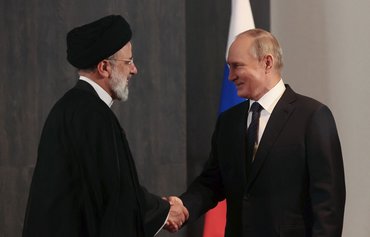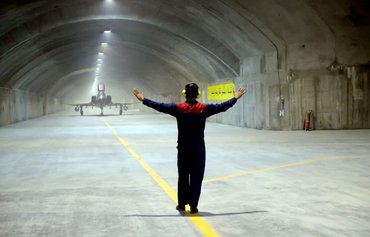Iran and Russia have stepped up their co-operation in the defence sector, with the Islamic Republic building a drone factory in Russia at the same time as it is using new Chinese parts in the manufacture of its drones.
Iran is also seeking to acquire large numbers of Russian attack helicopters, warplanes and air defence systems in repayment for providing Russia with unmanned aerial vehicles (UAVs, or drones), the Washington Post reported Friday (June 9).
The White House has warned that these weapons could substantially increase Tehran's ability to threaten its neighbours or repel future attacks.
Details of the exchange were released as part of an intelligence assessment on the deep military ties between the two countries, which also confirmed previous reports about Iran's drone factory in Russia.
![Iran has been supplying Russia with drones that the Kremlin is using in its war on Ukraine. The Iranian 'Gaza' drone -- unveiled in 2021-- is seen here. [Hamshahrionline]](/cnmi_am/images/2023/06/14/42547-Iran-drone-Gaza-600_384.jpg)
Iran has been supplying Russia with drones that the Kremlin is using in its war on Ukraine. The Iranian 'Gaza' drone -- unveiled in 2021-- is seen here. [Hamshahrionline]
![Iran and Russia are increasing their defence co-operation. On May 17, the presidents of the two countries met via video link ahead of a deal to build the Rasht-Astara railway. [Mikhail Klimentyev/SputnikAFP]](/cnmi_am/images/2023/06/14/42546-Iran-Raisi-Putin-600_384.jpg)
Iran and Russia are increasing their defence co-operation. On May 17, the presidents of the two countries met via video link ahead of a deal to build the Rasht-Astara railway. [Mikhail Klimentyev/SputnikAFP]
In February, the Wall Street Journal reported that Iran and Russia had plans to build a drone factory in Yelabuga, about 965km east of Moscow, which could manufacture at least 6,000 drones for the war in Ukraine.
"This is a full-scale defence partnership that is harmful to Ukraine, to Iran's neighbours and to the international community," said White House National Security Council spokesman John Kirby.
While Tehran has consistently denied providing drones to Russia for use against Ukraine despite ample evidence, it announced its allegiance to Russia on the heels of the new revelations about drone transfers.
On June 12, Iranian foreign ministry spokesman Nasser Kanaani said Iran's "defence co-operation with Russia takes priority over the war in Ukraine".
"No one can raise doubts about the defence co-operation between Iran and Russia," he said, yet denying once again that Tehran has supplied Moscow with drones.
Images of drone factory
The White House released satellite images of a facility in the Yelabuga Special Economic Zone in Tatarstan, an internal Russian republic. The factory, according to US officials, is meant to assemble Iranian drones, for which Iran is providing the materials.
"This plant could be fully operational next year," Kirby said.
The White House also released a map of what officials said was the supply route for Iranian drones heading toward Russian launch sites to the north and east of Ukraine, the Washington Post reported.
According to the map, drones are shipped from northern Iran across the Caspian Sea to the Russian port of Makhachkala, and then overland to a pair of Russian military bases near the Ukrainian frontier, it said.
On June 9, the New York Times reported that its examination of satellite imagery shows a series of new buildings constructed in the industrial area of Yelabuga since 2021.
Construction started at the end of January 2021, and a small structure was recently added, the Times review showed.
These recent findings clarify how Moscow will pay Tehran for the drones that have been used in the war on Ukraine.
Earlier in the year, the Iranian government announced a finalised deal to purchase the Russian-made Su-35 multi-role fighter jet.
The Kremlin will provide Iran with aircraft and military equipment in exchange for drones and drone materials.
New reports say Tehran is to receive more combat and trainer aircraft, attack helicopters, air defence systems, military radars and militarily sensitive electronics, equipment totaling in the "billions of dollars", Kirby said.
Drone parts from China
According to a Monday Wall Street Journal report, an Iranian drone brought down by Ukrainian forces in April contained a voltage converter that appeared to have been made in China in mid-January.
The revelation shows that China has continued to ship to Iran the building blocks for its drone programme, despite increasing pressure from the United States to choke off the global supply chain, the report said.
It also shows that Iran needs just three months to manufacture and supply Moscow with weapons that it can use against Ukraine's civilian population, the newspaper said.
This marks the first time a part made in 2023 has been found in the drones by researchers with Conflict Armament Research, a UK-based group that tracks global weapon supply chains, it said.
The 2023 Chinese part discovered by the group in the largely intact V-shaped drone, known as a Shahed-136, was in the weapon's navigation system.
The investigation demonstrated that the Chinese part was made in January, shipped to Iran, installed, sent to Russia and used against Ukraine in April, the report added.
Last month, the Biden administration said that Moscow has requested more attack drones from Iran after it ran out of supplies. Last week, the White House said that Iran had recently sent hundreds of drones to Russia on ships going across the Caspian Sea.
Measures to disrupt Iran's plans
"We are continuing to use all the tools at our disposal to expose and disrupt these activities including by sharing this with the public -- and we are prepared to do more," Kirby said.
"Actors like Iran want this kind of behaviour to be secret. We are shining a light on it publicly to let Iran know we are aware of exactly what they're doing, and to build pressure on Iran internationally, having alerted other countries to Iran's actions," a US official told Politico on condition of anonymity.
The United States has sanctioned several Chinese firms and other entities involved in the production and transfer of drones by Iran for Russia's use against Ukraine, and Kirby said it will continue to do so.
The Biden administration, the European Union and the United Kingdom have taken measures to restrict the transfer of electronic components found in Iranian drones in Ukraine.

![A resident inspects her belongings in a damaged residential building after a Russian drone attack in Odesa, Ukraine, on June 10. [Oleksandr Gimanov/AFP]](/cnmi_am/images/2023/06/14/42545-Iran-Ukraine-drone-600_384.jpg)






